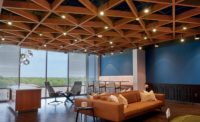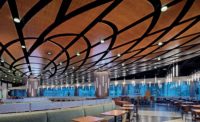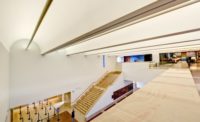Following completion of a $20 million revitalization, visitors to Westfield Santa Anita Mall in Arcadia, Calif., now have an opportunity to relax in a sophisticated Center Court that serves as a meeting place for the entire mall.
When designing the space, Westfield Design & Construction, of Century City, Calif., envisioned a new living room or lounge environment that would attract visitors to the 41,500 square foot space.
“We wanted the Center Court to be the new central meeting place—or living room—for the property,” says Lead Architect John Reistetter. “To accomplish this, we had to break down the volume of the space.”
Reistetter desired an architectural element that would reduce the scale of the exposed 80-foot ceiling and define the Center Court as a unique space. “We needed a second ceiling layer—something that would bring the ceiling closer to the floor—while allowing transparency to the clerestory windows in the existing ceiling,” he explains.
The design concept the architect developed called for a ceiling treatment that resembled an open white trellis. “The trellis concept came in as a filtering element,” adds Consulting Architect Bob Mahlebashian. “Something that would filter what’s above from what’s below.”
The design team created a prototype of one of the slats and hired Specialty Ceiling Contractor Martin Integrated Systems of Orange, Calif., to design and install a ceiling system that would realize their design vision.
While the initial design concept called for the ceiling trellis to be made from wood, the contractor recommended that it be made from metal instead. “I suggested they use lightweight metal because it is easier to handle and seismically safe,” says Marty Hovivian, president of Martin Integrated Systems.
Using a cocktail napkin, Hovivian drew a sketch of a metal ceiling system that would help Westfield achieve its design objective. “The metal panels were smaller and closer together (than the original concept),” explains Hovivian, “but it was similar to what they were looking for and they agreed to it.”
Designing the Ceiling Trellis
Collaborating with the You Inspire Solutions Center at Armstrong Ceiling and Wall Solutions, the contractor was able to specify a custom metal ceiling system that met the criteria for the trellis design. The You Inspire Solutions Center is a complimentary service offered to architects, designers and contractors to help them bring one-of-a-kind ideas like the ceiling trellis to life. After reviewing the renderings and initial sketches, the You Inspire team realized that some existing custom systems could be modified to create the parts and pieces needed to meet the design intent of the architect.
The result was a custom MetalWorks Baffle ceiling system installed in two runs on each side of the Center Court. Each run of the white aluminum panels is roughly 226 feet long and 26 feet wide. The panels are 12 inches high and 23/8 inches deep with 3-foot vertical returns at each end. They are installed approximately 16 inches apart on center at a height 45 feet above the floor.
“What was built there was never built before,” says Hovivian. “These parts were all custom factory-finished, which is difficult for a fabricator to do. We gave Armstrong Ceilings the dimensions and locations for each of the panels and they took the drawing and fabricated them according to our specifications.”
After seeing a mockup demonstrating how the metal panels would fit around the vertical concrete columns in the Center Court, Westfield gave Martin Integrated Systems permission to move forward with the ceiling installation.
Meeting the Seismic Requirements
Before installing the panels, the ceiling contractor designed a drywall suspension system that complied with the load carrying and seismic requirements for the area. “We had to build vertical faces out of the drywall grid and brace them to control movement of the panels,” explains Hovivian. “During an earthquake, the ceiling moves left to right. The vertical face provides the seismic control needed to keep the panels from breaking free during seismic activity.”
The custom clips provided to attach the blades to the suspension system also had to be tested to make sure they could withstand a seismic event. “You don’t want the whole thing shaking from the ceiling and falling down,” he says. “The whole ceiling system has to work together to meet the seismic requirements.”
Installing the ceiling above the storefronts presented the contractor with another challenge. “We weren’t allowed to scaffold the stores because we weren’t permitted to do anything that would disrupt business,” says Hovivian whose crew worked the overnight shift to avoid making noise during the day. “We had to use knuckle booms to get the crew and the materials over to the other side of the scaffold so they could install the ceiling above the stores.”
From Napkin Sketch to Complete Installation
Working on a tight deadline, Martin Integrated Systems completed the ceiling installation within six months from seeing the initial rendering. “What was unique about this job was that it started with a sketch I made on a cocktail napkin,” says Hovivian. “We actually executed and built something from a napkin drawing to simulate what the owner wanted in an incredibly short period of time. We went from napkin sketch to a complete install in six months.”
The Westfield design team was pleased with the result, describing the ceiling treatment as one of the most successful elements of the overall project. “The white Baffle ceiling system aesthetically defines the way we wanted the space to appear,” says Reistetter. “It breaks down the overall volume of the Center Court while allowing illumination from the clerestory windows and providing contrast to the darkly-painted existing ceiling. It creates an ambience and makes the space feel more intimate.”







